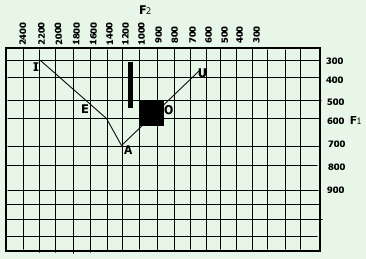It is the back part of the tongue which is raised
in the production of this vowel, the tongue height
being the same as for the English [u] as in put,
but being lower than that for the cardinal vowel no.8.
Concomitantly, the velum is raised and the lips rounded.
|
| It occurs word-medially and -finally. |
|
Medial
|
ķkhrūmĕ |
‘bachelor’ |
| rŁkhū |
‘buttocks; croup; hindquarters’ |
|
Final
|
| ōcŭ |
‘phallus’ |
| ōkrś |
‘cluster’ |
|
|
The vowels [i], [t] and [u] have nonsyllabic
variants when they form part of a diphthong and do not carry any tone. |
2.2.2
|
Mao vowel Formant Frequencies
at a Glance |
| Vowel |
i |
e |
a |
t |
o |
u |
| F1 |
300 Hz |
450 Hz |
650 Hz |
300-500Hz |
450 - 600Hz |
350 Hz |
| |
|
|
|
|
|
|
| F2 |
2100 Hz |
1500 Hz |
1200 Hz |
1150 Hz |
850-1000 Hz |
650 Hz |
| |
|
|
|
|
|
|
| duration |
200 MS |
250 MS |
75 MS |
250 MS |
200 MS |
220 MS |
| |
except |
|
except |
|
|
|
| |
word- |
|
word- |
|
|
|
| |
finally |
|
finally when it is 140 MS |
|
|
|
| |
when it is 250 MS and in high toned syllables, when
it is 400 MS |
|
|
|
|
|
|
2.2.2.
|
Vowel Triangle showing the Relative Positions of Mao Vowels |
|
 |
2.2.3.
|
Nasalization |
Unexpected though in Tibeto-Burman, the feature
of nasalaization is very much a part of Mao Naga phonology. Its functional
load, however, is rather low. Two of a very few minimal pairs are
|
ōh |
‘pus’ |
| ōhį |
‘kind of pumpkin, not edible, but which is, when
ripe,used to fashion containers to stash away water, wine etc.’ |
phķh |
‘foot print’ |
| phķhķ |
‘to shoot [as with spear]’ |
|
Contrast with all the vowels is hard to come by, but
all the vowels in the system could be nasalized. Notably,
the nasalized vowel invariably follows [h], the sole
exception being  ‘yes’
‘yes’
|
ih |
‘forest’ |
o h h |
‘sun’ |
h  hģkņmņpe hģkņmņpe |
‘spinster’ |
h h h |
‘snivel, snot’ |
ģh |
‘kind of soft bamboo’ |
|